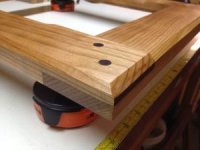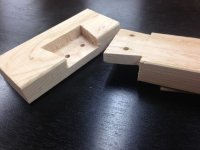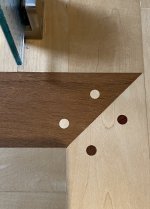I don't use a domino, but I do dowel often. For me, the straight run is going to be easier to clamp a half-lap than a butt joint no matter what inserts you use (domino, biscuit, dowel, floating tenon, etc.). The strength is going to be adequate regardless of which joinery method is chosen from the above.
On a table saw, the half-lap is a cinch to execute. It works equally well going straight, in corners or T-joints.
Most people (and that includes most daughters) will not appreciate the difference in the joinery method. It is rare that people are impressed with the craftsmanship involved. It appeals to the woodworker more that to the recipient of the gift.
I do like the appearance of the Amish looking half-lap plus pegs. I have a mortising machine and I prefer square pegs, but dowel pegs look good too, especially in contrasting woods.
If I am pegging the joint, I forgo the clamping entirely. I drill pilot holes where the pegs will go and drive short pan head screws in, in place of the clamps. I remove the screws once the glue is dry and then add the pegs.




